Endodontic Obturation
Although periapical healing starts after Root canal cleaning, shaping and disinfection is done, it is an accepted scientific fact that good obturation is needed for it to stay healed over the years.
An Obturation should :-- Prevent recolonization of the root canal system with microorganisms that can produce destructive functions by the host tissues
- Prevent Periapical disease in teeth with vital pulps.
- Prevent Periapical Disease in teeth with necrotic pulps and no radiolucency
- Heal Periapical disease in teeth with obvious clinical and radiographic symptoms
Proper root canal filling should achieve three dimensional obturation of the endodontics space to prevent micro organisms from entering and reinfecting the root canal system and to prevent tissue fluids from percolating back into the root canal system to provide a culture medium for any residual bacteria. It should seal all “portals of exit” to impede any sort of communication or exchan- ge between the endodontium and periodontium.
It is clear from the objectives that the most critical area is the apical terminus of the root canal. While attempting to provide a hermetic seal in this region, we have to keep in mind that when heated gutta percha cools, always there is contraction. Even though thermo plasticized gutta percha techniques are fast and good enough for obturating the body of the root canal, it cannot give a hermetic seal in the apical third.
Most dentist do not understand correct tug back. It is very important not to confuse Apical Tug back with Taper Lock or Curve Lock which can misguide you and then increase your case Failure. Come join learn World Class Rotary Endo NOW...CLICK HERE
Another important consideration is that if a post space is to be prepared or in the event of a re- root canal treatment, we should be able to remove the obturation without jeopardizing the integrity of the remaining tooth structure. So it is preferable to use a technique that doesn’t leave a ‘difficult to remove’ carrier in the root canal.
Obturation Techniques:-
Lateral condensation :-
Lateral condensation is a good technique where it is indicated, and it has withstood the test of time.
Root canal spreaders for lateral condensation:

Vertical condensation:-
Advocated by Herbert Schilder, vertical condensation requires a set of variable diameter pluggers.
Warm gutta percha techniques:-
1.JS Quick-FillAlpha phase gutta -percha, on special design titanium carrier, JS Quick-Fill gives you a control, smooth obturation all in a single step.
- No heating units or open flame.
- Works with friction heat.
- Fit in your low speed handpiece.
- Chairside efficiency.
- The operator cannot control extrusion of obturating material
- The instruments can break
- If the file is turning in reverse, it can screw itself into the canal and periapical tissues
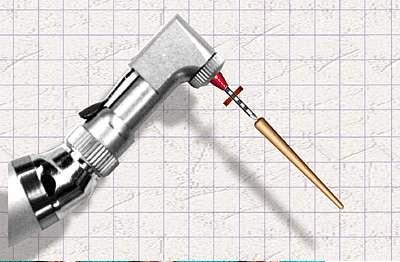 2. Thermoplasticized injection techniques (Obtura and Ultrafil)
2. Thermoplasticized injection techniques (Obtura and Ultrafil) - Length control is a disadvantage
- Canal preparation must be sufficient to permit placement of the needle to within 4-6 mm of the apical preparation
This warm gutta percha-delivery system can be quickly and efficiently incorp-orated with all down-packing techniques. It is helpful in cases of internal resorption.
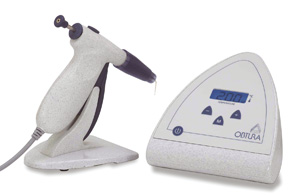 3. System B - The Continuos Wave of Condensation (L. S. Buchanan, 1987)
The System B heat source can monitor the temperature at the tip of its heat carrier device, delivering a precise amount
of heat for an indefinite time without overheating the gutta-percha. These heat carriers are designed to soften the
gutta-percha and at the same time condense it. The Continous Wave Technique requires only one plugger versus four or
five when utilizing the Vertical Condensation Technique as described by Dr. Schilder.
3. System B - The Continuos Wave of Condensation (L. S. Buchanan, 1987)
The System B heat source can monitor the temperature at the tip of its heat carrier device, delivering a precise amount
of heat for an indefinite time without overheating the gutta-percha. These heat carriers are designed to soften the
gutta-percha and at the same time condense it. The Continous Wave Technique requires only one plugger versus four or
five when utilizing the Vertical Condensation Technique as described by Dr. Schilder.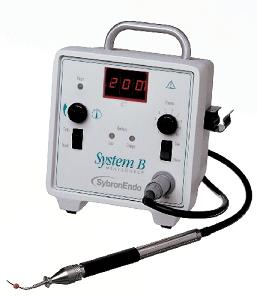 Sybron has just come out with the New Cordless System B, see the pic below
Sybron has just come out with the New Cordless System B, see the pic below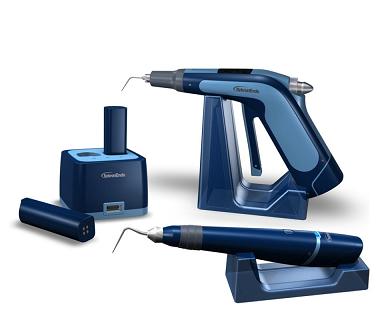 CLICK HERE FOR MORE INFO
CLICK HERE FOR MORE INFO
SimpiFill obturation :-
SimpliFill is the only carrier system where the carrier is not left in the canal. We all know that removal of carrier is not a pleasant job if we have to go for a post or a retreatment has to be done. It is the best hermetic seal you can obtain for your well prepared canal. When you push a 5mm of .02 tapered gutta percha into a 4mm of parallel apical preparation, you can understand that we are providing a cork like tight seal for the apical third.
To me the best advantage of SimpliFill is the opportunity to finish the post cementation in the same sitting. Because of the tight apical seal, I don’t have to worry that the vibration during the post space preparation may dislodge the gutta percha or compromise the apical seal.
Equally important are cases with severely curved root canals and canals with curvatures in two planes. LightSpeed LSX system makes possible cleaning and enlarging the canal
and it is only SimpliFill that can make sure the gutta percha reaches to the apical extent and a hermetic seal is provided. We can’t push a gutta percha point into such canals
because they will buckle and won’t reach till the full working length
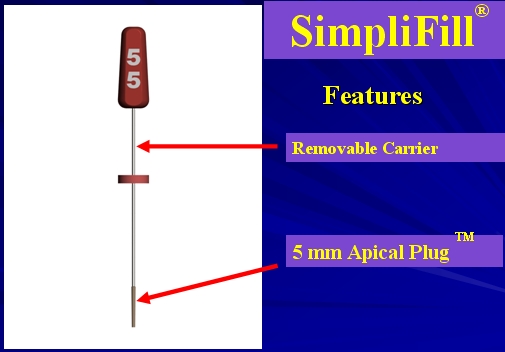
HotShot Cordless Obturation device
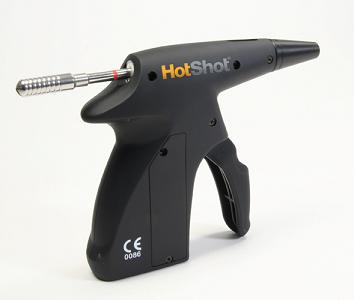
- Completely cordless
- Multiple Uses on Single charge
- Easy to Clean
- Minimal heat tranmittance
- Wide range of temperature settings
GuttaFlow
GuttaFlow® is a completely novel filling system for root canals that combines two products in one: gutta-percha in powder form with a particle size of less than 30 µm, and sealer. This new filling system works with cold free-flow gutta-percha, and uses an application system developed to enable an absolutely simple, safe and hygienic procedure. More HEREGutta flow is by Coltene, same company also sells another injectable guttapercha obturation system name Ultrafil 3 D
Resilon
Resilon is a thermoplastic synthetic polymer based root canal filling material. Based on polymers of polyester, Resilon Material contains bioactive glass and radiopaque fillers. It performs like gutta-percha, has the same handling properties, and for retreatment purposes may be softened with heat, or dissolved with solvents like chloroform. Similar to gutta-percha, there are master cones in all ISO sizes and accessory cones in different sizes available. It can be bonded with tooth. There is still not enough evidence that Resilon performs better than Guttapercha. GP with lateral condensation continues to be GOLD standard for Endo obturation.
The Thermafil System- some call it Thermafilth, So Now it is called Guttacore
The Thermafil obturator consists of two parts, the carrier and the gutta-percha. The carrier is similar to a manual endodontic instrument without the blades, made from a special radio-opaque plastic. Carrier is coated with GP. Thermafil obturators have a taper of .04 and are available in various tip sizes starting from size 20 to 140. The chosen size is placed in a special oven and this warm cone is then pushed into canal giving a 3D filling. However cooling does lead to some shrinkage.
Disadvantages of Thermafil
This technique leaves a plastic carrier in the canal which poses a problem should you have to place post or retreat the case.
Special oven (therma prep plus oven) is required to heat thermafil cones.
In curved canals carrier usually gets stripped of GP in curvature.
You needs special technique and time to remove nasty carrier in cases which need post core or retreatment.
Many companies have copied this product, "Stay away from Thermafil and its likes"
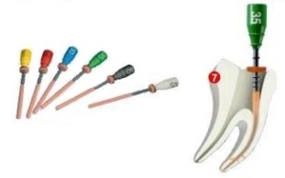
Thermaflo is similar to Thermafil, CLICK HERE TO SEE
SmartSeal- Obturation system with claim that on contact with canal fluids the obturation point will expand and seal the canal. MORE HERECalamus 3 D obturation System by Dentsply
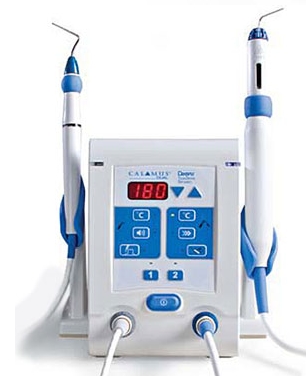 Calamus offers downpack and backfill obturation techniques. With the Pack and Flow positioned side-by-side, dentists can move smoothly from one step to the next. Use the Pack to create an effective and dense apical plug, then use the Flow to deliver the gutta-percha backfill at the perfect temperature and flow rate. Each ergonomically-designed handpiece features a 360-degree activation cuff providing ultimate control whether delivering a smooth, continuous expression of gutta-percha or successfully placing an apical plug.
For Technique details and Videos CLICK HERE
Calamus offers downpack and backfill obturation techniques. With the Pack and Flow positioned side-by-side, dentists can move smoothly from one step to the next. Use the Pack to create an effective and dense apical plug, then use the Flow to deliver the gutta-percha backfill at the perfect temperature and flow rate. Each ergonomically-designed handpiece features a 360-degree activation cuff providing ultimate control whether delivering a smooth, continuous expression of gutta-percha or successfully placing an apical plug.
For Technique details and Videos CLICK HERE
Elements Obturation Unit by Sybronendo
The Elements Obturation Unit combines our System B™ technology with a motor-driven extruder handpiece to make obturation efficient, predictable, and accurate. From downpack to backfill, the Elements Obturation Unit puts the Continuous Wave of Condensation Technique into one simple-to-operate device that takes up only 1/3 the space of two separate machines.
Ultrasonic lateral condensation:
Example technique (use common sense)Insert ultrasonic spreader (F 88 009 –S04, Satelec by Acteon Group, Mérignac Cedex, France)alongside the master cone and activated with an ultrasonic unit (P-MAX, Satelec) for 3 seconds, push apically, and activate again for 3 seconds. Repeat until the spreader reaches 3mm short of the working length. Briefly activate (setting 3-5) and remove spreder and put a size 35 standardized gutta-percha cone, coated with sealer.Continue condensation until the canal is filled. Excess gutta-percha is seared off and the heated gutta-percha vertically condensed with an ultrasonic plugger (F 00 250-5, Satelec). LINK HERE
Endodontic sealers
Sealers play an important role in the obturation (filling) of a root canal. The sealer coats the walls of the canals and fills the space between the root canal filling material and the root. Their antimicrobial activity likely plays an important role in the overall documented success of endodontic therapy. There are many kinds of endodontics sealers. They can be grouped into these categories: 1. Zinc Oxide-Eugenol2. Calcium Hydroxide (Sealapex, CRCS, Apexit)
3. Resin modified sealer (AH26, AHPlus, Diaket, Endofill, Resilon)
Sealers may contain different medicaments for antibacterial activity etc. KeyPOINT: Canal has to be cleaned well, dirty apex can not be healed by sealer.
Tweet